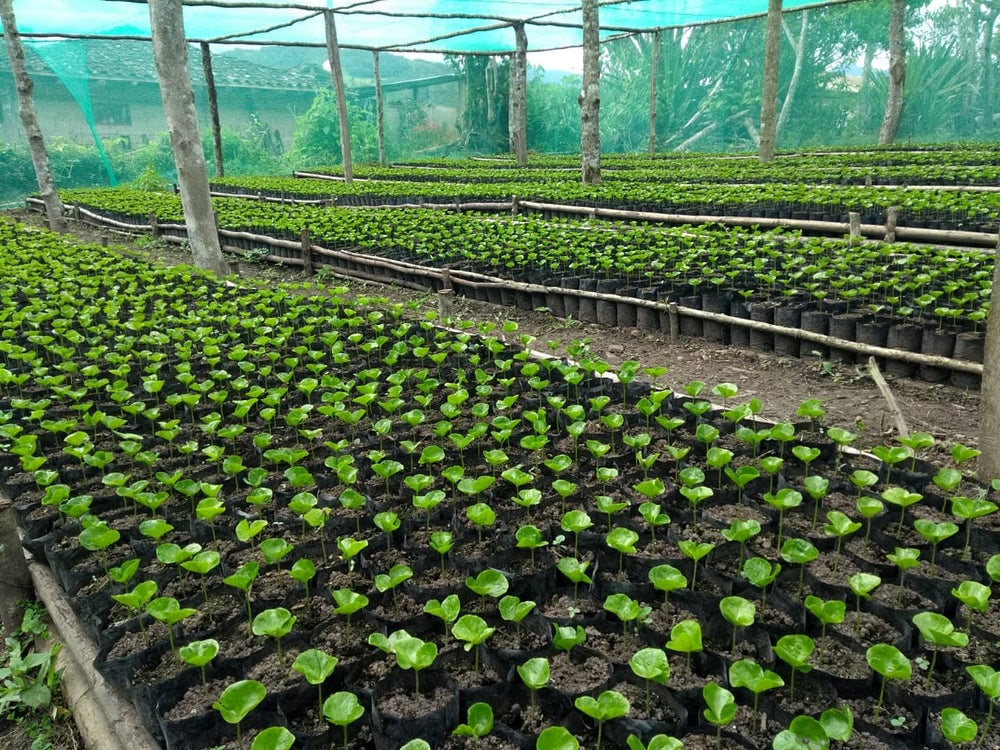From the Field, News
Monday, October 10, 2022
Production is Booming in Northern Peru
Northern Peru is fast becoming the biggest coffee producing region in Peru and we’re excited about what that can mean for the future of coffee in Peru. Felice Chay, Latin America Origination Coordinator, recently traveled to the departments of Cajamarca, Amazonas and San Martin to meet with producing partners and follow the latest developments. We sat down with Felice to learn about the changes she’s witnessed and how she thinks they will impact coffee quality and volume from Peru in the coming years.

Production is Booming
Felice has noticed several changes that indicate Northern Peru’s dominance in the coffee production, including new coffee plantings, a boom in cooperatives and the construction of new dry mills.
About 10 years ago, the majority of Peruvian coffee came from Peru’s central region. That has since changed, and more than 50% of total coffee volume comes from the north now. “Driving through San Martin and other areas of Northern Peru, I was seeing a ton of coffee plantations that had been planted just in the last few years,” Felice says. Older farms that were planting other crops been transitioned to coffee and farmers have been renovating existing farms. Young trees tend to be more productive and healthier, so we can expect to see higher quality and higher yields from these renovated farms.
In response to more coffee production, cooperatives have also expanded to serve coffee producers. “It’s wild how many new groups there are,” Felice says. “There are a ton of cooperatives, associations and exporters that have popped up in the last 1 to 5 years. The sheer quantity is a little shocking. I wasn’t able to get a concrete number of groups in Jaén, but I wouldn’t be surprised if there were close to a hundred groups.”
On the whole, more cooperatives mean more investment in coffee farms, a stronger focus on quality and more support for farmers, so that’s a positive thing. Coops often provide a lot of technical assistance and training in both production and processing. This year, since the harvest was smaller, the larger number of cooperatives and exporters is, unfortunately, creating more competition for scarce parchment, which has led to higher FOB prices in recent months.
A number of new mills have also opened up in recent years in Jaen. In the past, most cooperatives that exported coffee sent their parchment to dry mills in Piura or Chiclayo — hours and hours away. Coffee had to travel further and risk degradation due to temperature changes or time delays. The distance also meant it was harder for cooperatives to have oversight on milling quality. These new mills in Jaén are a lot closer to where many of the cooperatives are located, which saves the longer journey and allows them to monitor quality more closely. They are also equipped with newer, state-of-the-art equipment. “I think this will result in better quality, cost savings and more efficiency for everyone,” Felice says.
Quality Looks High
In general, coffee quality in Northern Peru this year is looking really good, Felice says. “I’m optimistic about the future, as well, because I can see that producers are continuing to invest in coffee and renovate their farms. There are projects to install solar dryers on farms and producers are also being selective about planting higher quality varietals. I was happy to see that cooperatives are continuing to improve their quality control protocols and are separating coffees that are standing out. I think there’s a lot of potential here.”
For more information about the upcoming harvest quality and supply, check out our recent Peru harvest update.
Building Strong Sourcing Relationships
Understanding these new changes in the Peruvian coffee sector is the first step to building long-lasting and beneficial relationships with sourcing partners there. “We want to know our supply chain really well,” Felice says. “There’s nothing like meeting sourcing partners in person. We get to cup with them, get a sense of how they’re organized, where their producers are located, who their leadership is and how they’re sourcing. This enables us to source great qualities at prices that support farmer success and benefit our roasting clients.”
Meeting producers and cooperatives in person gives us a chance to understand what each group’s strengths are. Some importers choose to work with just a few select exporters and source all their coffee from them year after year. “There are benefits to that, but we choose to work with a broad range of exporters and cooperatives because it allows us to provide our clients globally with a range of qualities, price points and cup profiles,” Felice says. “I like to have a good idea of who all the players are and then figure out which groups make the most sense for distinct needs in different destination markets. We try to know everyone, and that gives us flexibility.”
Having a range of suppliers also means that we have a more holistic picture of what’s going on with the harvest each year. “It’s about so much more than just buying and selling coffee. If we only have 4 or 5 suppliers in very specific regions, it wouldn’t give us a global picture of the harvest in Peru as a whole. Having more relationships means we get a better understanding of the dynamics of the internal market in each country.”
Coffee production in Peru is evolving, and largely for the better. We’re excited about the impacts these new cooperatives and dry mills will have on quality and volume in Northern Peru, and we can’t wait to bring those coffees to you. We already have several lots in-store. Now is the perfect time to speak with your trader and request samples to cover your needs this harvest.